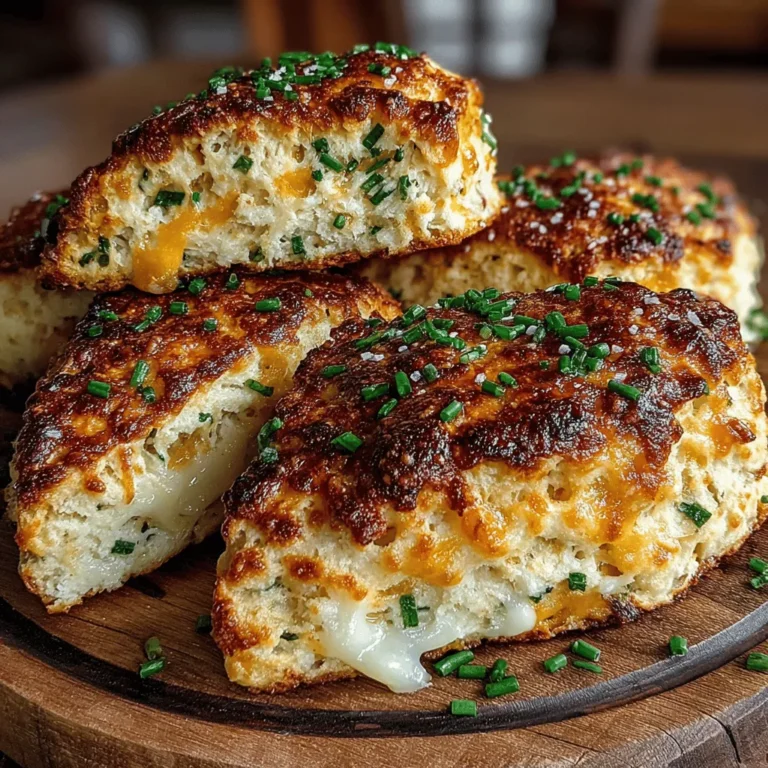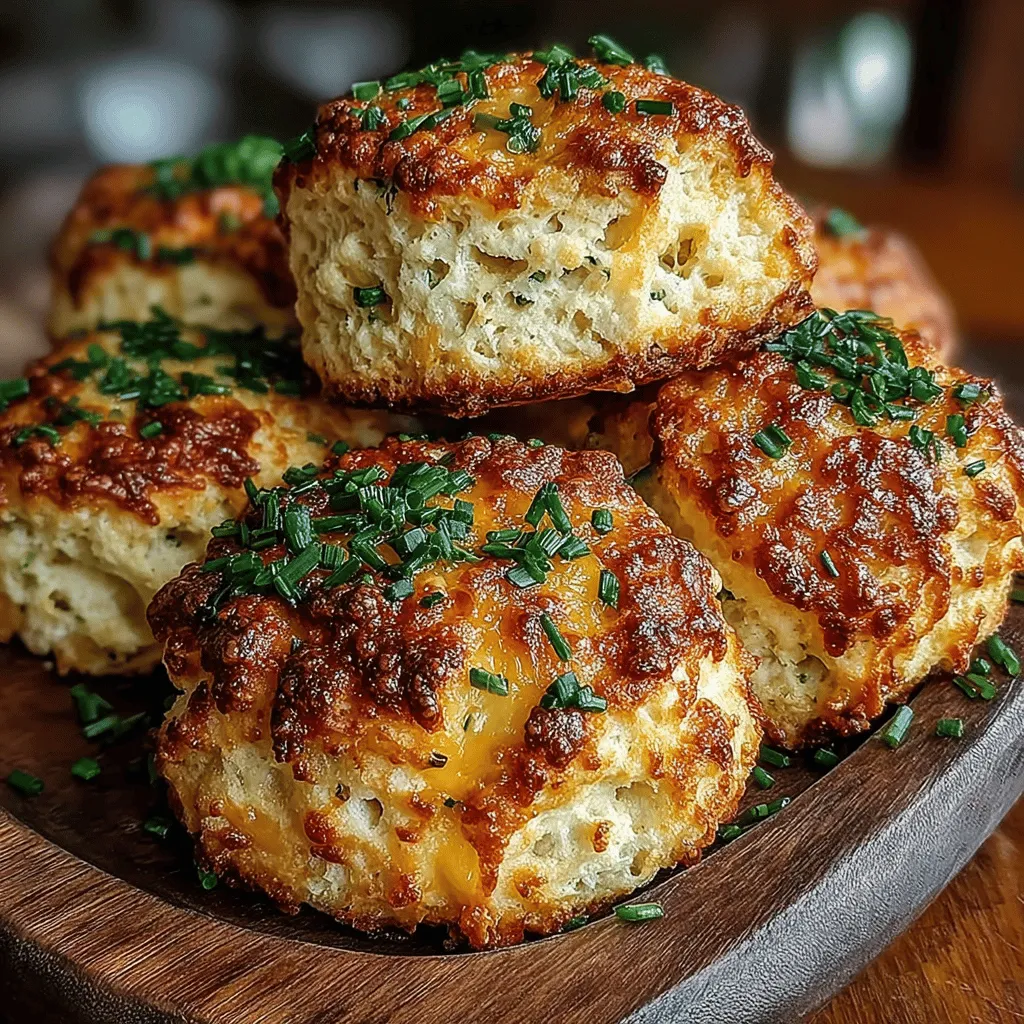Scones are a beloved baked good that has found its place in various culinary traditions, particularly in British cuisine. Their versatility makes them suitable for any time of day, whether enjoyed at breakfast, served at brunch, or snacked on throughout the day. This recipe for Savory Cheddar and Onion Scones offers a delightful twist on the classic scone, infusing rich flavors of sharp cheddar cheese and sweet onions. The result is a comforting, flaky pastry that is sure to please anyone who bites into it.
Ingredients
– 2 cups all-purpose flour
– 1 tablespoon baking powder
– 1 teaspoon salt
– 1/2 teaspoon black pepper
– 1/4 cup unsalted butter, chilled and cubed
– 1 cup sharp cheddar cheese, shredded
– 1/2 cup onion, finely chopped
– 2 tablespoons chives, chopped (optional)
– 3/4 cup whole milk
– 1 egg (for egg wash)
Instructions
1. Preheat your oven to 425°F (220°C) and line a baking sheet with parchment paper.
2. In a large mixing bowl, combine the all-purpose flour, baking powder, salt, and black pepper.
3. Add the chilled, cubed butter to the dry ingredients and use a pastry cutter or your fingers to mix until the mixture resembles coarse crumbs.
4. Stir in the shredded sharp cheddar cheese, finely chopped onion, and chives (if using) until evenly distributed.
5. Pour in the whole milk and mix until just combined, being careful not to overwork the dough.
6. Turn the dough out onto a floured surface and gently knead it a few times until it comes together. Pat the dough into a circle about 1-inch thick.
7. Cut the dough into wedges or use a round cutter to form individual scones and place them on the prepared baking sheet.
8. Beat the egg in a small bowl and brush the mixture over the tops of the scones for a glossy finish.
9. Bake in the preheated oven for 15-20 minutes or until the scones are golden brown and cooked through.
Understanding Scones: A Culinary Perspective
Scones have a rich history, originating in the United Kingdom during the 16th century. Traditionally, they are small, lightly sweetened baked goods often served with tea. Scones can be categorized into two types: sweet and savory. While sweet scones might include ingredients like sugar, fruit, or chocolate, savory scones, like our Cheddar and Onion Scones, focus on bold flavors and can be enjoyed without additional toppings.
The ideal scone should have a light and tender texture, achieved through the right balance of ingredients and proper handling of the dough. Key factors include the leavening agents used and how the fat is incorporated, affecting both the taste and mouthfeel of the finished product.
Ingredients Breakdown
– All-Purpose Flour: The backbone of the scone, all-purpose flour provides the necessary structure and texture, allowing the scones to rise while remaining tender.
– Baking Powder: This leavening agent is crucial for achieving that light and airy texture that scones are known for.
– Salt and Black Pepper: These seasonings enhance the overall flavor profile, balancing the richness of the cheese and butter.
– Unsalted Butter: Using chilled butter is key to creating flaky layers within the scone, while also contributing a rich flavor.
– Sharp Cheddar Cheese: The sharpness of the cheddar adds a robust flavor that elevates the scone beyond its sweet counterparts.
– Onion: Whether sautéed or used raw, the onion provides a savory depth that complements the cheese beautifully.
– Chives: An optional addition that brings a fresh, herbaceous note and a pop of color to the scones.
– Whole Milk: This ingredient is essential for moisture, creating a cohesive dough that holds together well.
– Egg Wash: The egg wash brushed over the scones before baking helps achieve a beautifully golden and glossy finish.
Step-by-Step Instructions for Perfect Scones
1. Preheat the Oven: Preheating to the correct temperature is vital for proper baking, ensuring the scones rise and develop a nice crust while remaining tender inside.
2. Mixing Dry Ingredients: It’s important to mix the dry ingredients thoroughly to ensure an even distribution of baking powder and salt, which will help the scones rise uniformly during baking.
Tips for Perfect Cheddar and Onion Scones
Incorporating Butter
To achieve the right texture in your scones, it’s essential to incorporate the butter properly. Start with cold, unsalted butter and cut it into small cubes. Use a pastry cutter or your fingertips to rub the butter into the dry ingredients until the mixture resembles coarse crumbs. This method ensures that the butter remains in small pieces, which helps create a flaky texture as the scones bake.
Adding Cheese and Onions
When mixing in the cheese and onions, do so gently to avoid overworking the dough. Sprinkle them over the flour mixture and use a folding motion with a spatula or your hands to combine. This technique helps distribute the flavors evenly without compromising the scone’s lightness.
Forming the Dough
The perfect dough consistency is slightly sticky but manageable. If it feels too wet, add a little more flour, but be cautious not to add too much. The dough should hold together but not be overly dry. A well-formed dough will yield tender scones with a nice rise.
Shaping the Scones
For uniform baking, shape the scones into equal-sized rounds or triangles. Use a sharp knife or a dough cutter to create clean edges. Avoid twisting the cutter as this can seal the edges and prevent the scones from rising properly. Place them on a baking sheet lined with parchment paper for easy removal.
Preparing for Baking
Proper spacing on the baking sheet is crucial. Leave about an inch between each scone to allow for expansion as they bake. Applying an egg wash (a beaten egg mixed with a splash of milk) on top before baking gives the scones a beautiful golden color and a shiny finish.
Baking
Preheat your oven to 400°F (200°C) for ideal baking conditions. Bake the scones for about 15-20 minutes or until they are golden brown on top and cooked through. Keep an eye on them during the last few minutes to avoid over-baking, as every oven can vary slightly.
Cooling and Serving
Once baked, let the scones cool on a wire rack for a few minutes. They are best served warm, allowing the cheese to be slightly gooey and the flavors to meld beautifully. For an extra touch, consider serving them with a pat of butter or your favorite spread to enhance their savory profile.
Flavor Variations and Customizations
Cheese Alternatives
Experiment with different types of cheese to create unique flavor profiles. Gouda offers a creamy texture, while Gruyère adds a nutty flavor. Mixing different cheeses can also provide a delightful depth to your scones.
Onion Substitutes
If you want to switch things up, consider using scallions or shallots for a milder taste. Roasted garlic can also add a sweet, caramelized flavor that complements the cheese beautifully.
Adding Vegetables
Incorporating vegetables like spinach or sun-dried tomatoes not only boosts nutrition but also adds color and flavor to your scones. Be sure to chop them finely and squeeze out any excess moisture before mixing.
Enhancing Herbs
Fresh herbs can elevate your scone recipe. Try adding rosemary, thyme, or dill for a distinct flavor that pairs well with the cheese and onions. Experiment with different combinations to find your favorite.
Pairing Suggestions
Ideal Beverages
Cheddar and onion scones pair well with a variety of beverages. A hot cup of coffee or a soothing tea complements their savory flavors perfectly. For a more sophisticated touch, consider serving them with a light white wine.
Complementary Spreads
Enhance your scone experience with spreads. Classic butter, cream cheese, or herbed spreads can add an extra layer of flavor. Consider making a simple herbed cream cheese by mixing cream cheese with fresh herbs for a delightful accompaniment.
Serving Suggestions
For a stylish presentation at brunch or gatherings, arrange the scones on a tiered serving platter. Garnish with fresh herbs or a small bowl of your chosen spread to create a visually appealing table setting.
Nutritional Information
Overview
These Cheddar and Onion Scones offer a delightful combination of flavors and textures, but it’s also important to be mindful of their nutritional content. They are a source of carbohydrates and fats, primarily from the flour and butter.
Healthier Alternatives
To make your scones a bit healthier, consider using whole wheat flour instead of all-purpose flour for added fiber. You can also reduce the amount of butter or substitute it with Greek yogurt for a lighter option without sacrificing flavor.
Conclusion
Making Cheddar and Onion Scones is a rewarding culinary experience that results in delicious, comforting baked goods. The versatility of the recipe invites experimentation with flavors, allowing you to create a personal touch. Enjoy the process of baking and savor the joy of sharing these delightful scones with family and friends. Embrace the comfort of homemade treats that not only satisfy the palate but also fill the home with warmth and aroma.



